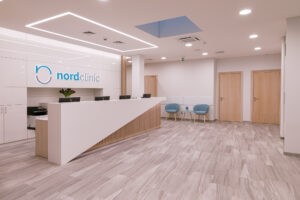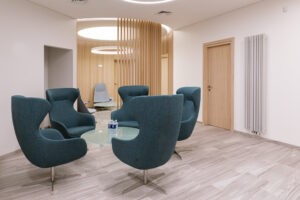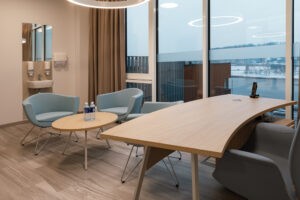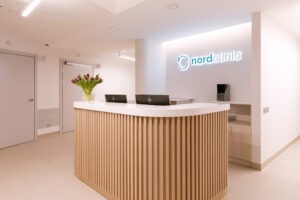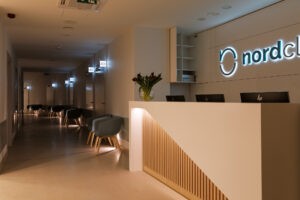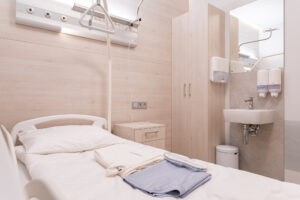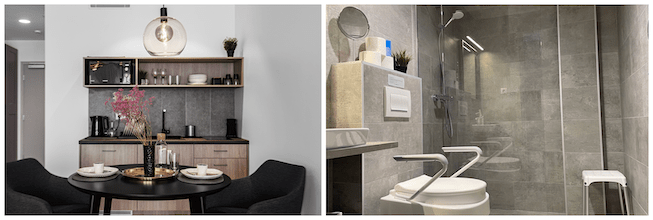Varicose Veins Treatment In Lithuania
Leading medical tourism clinic
We are the leading medical tourism clinic in the Baltic region with over 10 years of experience. We are proud of the fact that around 90% of our patients come from abroad: the UK, Ireland and Scandinavian countries – this is the area we specialise in and our processes have been adapted to cater specifically for patients from abroad. Our team of surgeons perform over 4.000 surgeries per year, mostly plastic, bariatric, orthopaedic, general and gynecological surgeries.
See before-after pictures
Reviews & Facebook group
Our patients and clinic in the media
Prices
- consultation with ultrasound – 155 £
- endovenous laser ablation (EVLA) one leg – 1.700 £
- endovenous laser ablation (EVLA) two legs – 2.100 £
- mini phlebectomy in combination with EVLA – 80 £
- micro phlebectomy – 1.400 £
- sclerotherapy (one session) – 200 £
Popular combination – EVLA treatment & eyelid surgery – from 2.550 £
- consultation with the surgeon
- necessary health tests
- surgery
- anaesthesia
- hospitalisation
- 24/7 personal assistance during your stay
- transfers to / from the airport, hotel and clinic
- all documents translated to English
Get your surgery for free by claiming a refund from your local health board. The clinic helps patients with the documents needed to claim a refund after following the EU directive route for medical treatment abroad. It applies to patients who are insured under the systems of one of the EU countries and may not get the surgery due to long waiting times.
Save time and money by combining your varicose vein treatment. Often combinations with ELVA treatment :
- Plastic surgeries:
- Eyelid surgery – 1.100 £
- Otoplasty – from 1.000 £
- Gynecological procedures – from 750 £
- Hernia surgery – from 1.400 £
- Orthopaedic surgeries:
- Hallux Valgus – 1.400 £
- Cheilectomy (Hallux Rigidus) – 1.580 £
- Toe shortening surgery – from 1.580 £
- Hammertoe surgery – 1.770 £
Combining multiple surgeries (depending on procedures combined) the discount can be as much as 10% in the total price.
- consultation with ultrasound – 180 €
- endovenous laser ablation (EVLA) one leg – 2.000 €
- endovenous laser ablation (EVLA) two legs – 2.500 €
- mini phlebectomy in combination with EVLA – 100 €
- micro phlebectomy – 1.700 €
- sclerotherapy (one session) – 250 €
Popular combination – EVLA treatment & eyelid surgery – from 3.065 €
- consultation with the surgeon
- necessary health tests
- surgery
- anaesthesia
- hospitalisation
- 24/7 personal assistance during your stay
- transfers to / from the airport, hotel and clinic
- all documents translated in English
Get your surgery for free by claiming a refund from your local health board. The clinic helps patients with the documents needed to claim a refund after following the EU directive route for medical treatment abroad. It applies to patients who are insured under the systems of one of the EU countries and may not get the surgery due to long waiting times.
Save time and money by combining your varicose vein treatment. Often combinations with ELVA treatment :
- Plastic surgeries:
- Otoplasty – from 1.150 €
- Eyelid surgery – from 1.300 €
- Gynecological procedures – from 900 €
- Hernia surgery – from 1.600 €
- Orthopaedic surgeries:
- Hallux Valgus – 1.710 €
- Cheilectomy (Hallux Rigidus) – 1.900 €
- Toe shortening surgery – from 1.900 €
- Hammertoe surgery – 2.120 €
Combining multiple surgeries (depending on the procedures combined) the discount can be as much as 10% in the total price.
Phlebology and vascular surgeon Irmantas Rutkauskas
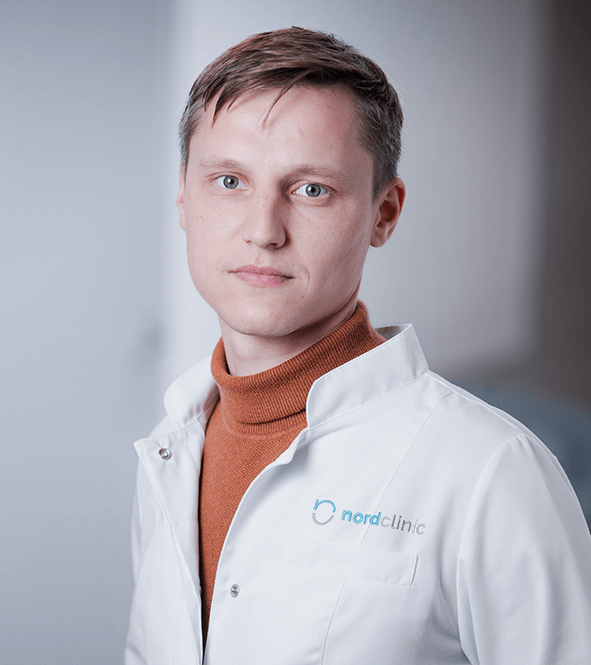
- Specializes in minimally invasive treatment of peripheral varicose veins, sclerotherapy, aesthetic vein surgery
- Fluent in English
- Member of European Society for Vascular Surgey
- Had trainings in Spain
Direct flights to Lithuania





Our clinic
Self-catered accommodation with medical care
Varicose veins treatment
What are varicose veins? What are the types of varicose veins?
Varicose veins, also called varicoses, are superficial vessels that are enlarged and twisted in appearance. Normally, veins carry the blood from the feet up to the heart but varicoses disturb normal blood flow, causing blood stasis and swelling. That is why varicoses not only look aesthetically unpleasing but also come with a number of health concerns, including swelling, chronic pain, and soreness in the legs.
There are a few types of varicose veins: spider veins, reticular varicose veins, and saphenous varicose veins. Spider veins are thin strikes of red, green, or purple, that spread in a web-like pattern and can be found anywhere in the body. Reticular varicose veins appear in blue, red, or green tones and spread like a mesh, covering a wide area of the skin. Saphenous varicose veins are the ones that tend to swell and bulge out from the skin. They look extremely unsightly and cause a lot of discomforts.
How are varicose veins diagnosed? What arethe symptoms?
Varicosities are diagnosed during a physical examination and a Doppler ultrasound test. Doppler ultrasound measures vascular flow and detects abnormal blood flow patterns. The test takes about 20-30 minutes and is completely painless.
Varicose veins present with a number of common symptoms that include aching, heavy legs, swelling of the feet and ankles, burning sensations, muscle cramps, and dry skin over the affected veins. In severe cases of varicose veins, enlarged and twisted veins lead to the formation of extremely painful sores.
What are the treatment options for varicose veins?
First choice treatment options are lifestyle changes, compression stockings, and sclerotherapy. Patients are recommended to quit tobacco, try to lose excess weight, and keep their feet elevated to reduce swelling. Compression stockings encourage circulation by applying pressure to the legs, ankles, and feet. Sclerotherapy involves injecting a special solution that diminishes the appearance and effectively treats spider veins, reticular varicose, and subcutaneous varicose veins.
If conservative measures are ineffective, patients can choose surgical varicose vein treatment. There are two types of varicose vein surgeries: those that close the veins and those that remove them. The former category includes endovenous laser ablation therapy (EVLA) which is one of the most popular procedures for varicoses. Removal of the veins can be performed through ambulatory phlebectomy or vein stripping and ligation. The right procedure is chosen based on several things, like age, the extent of the symptoms, and desired goals.
Who is an eligible candidate for varicose vein treatment?
A good candidate for varicose vein treatment is someone with persistent pain caused by varicose veins despite non-surgical treatment methods, like losing weight, exercising, and wearing compression stockings. Good candidates are between 30 and 60 years of age and have generally good health. However, surgical varicose vein treatment cannot be performed on women who are pregnant or breastfeeding.
How to prepare for varicose vein surgery?
On the day of the surgery, a patient should arrive with loose-fitting clothes and without jewellery, piercings, or contact lenses. It is necessary to refrain from food and drinks for at least 8 hours until surgery.
How is varicose vein surgery performed?
The most popular surgery for varicose veins is endovenous laser ablation (EVLA). The surgery takes about 20-30 min. per leg under local anaesthesia. A surgeon inserts a laser fiber so its tip lies at the highest point (most often in the groin crease). The laser is then turned on and pulled down the vein over about 5 minutes. The laser light causes the vein to contract and close. Previously stagnant venous blood can now flow into normal veins and continue to be carried to the heart. Once the surgery is over, the doctor covers the needle puncture with a small dressing and puts on a compression stocking.
What are the risks associated with varicose vein surgery?
Even though serious complications are very rare, patients should be informed about the possible risks of infection, bleeding, scarring, allergic reaction to medications, temporary numbness of the skin, thermal injury (burn), a clot in a deep vein, and others.
What is the after care?
- After surgery, patients have to wear stockings for up to 2 weeks. While wearing the compression stocking, patients should avoid getting it wet.
- Moderate pain or discomfort in the surgical site is normal and anti-inflammatory medicines, like ibuprofen, can be taken to relieve it.
- After surgery, patients should try to change position regularly and avoid sitting or standing for a long time. It is best to keep the leg elevated when sitting or laying down.
- Patients should also avoid lifting heavy objects and exercising heavily for about 1 to 2 weeks after the surgery.
- It is recommended to avoid wearing tight clothing, especially around the waist and legs.
How soon a patient recovers after the surgery? Is the result permanent?
Patients can get back to work and get on with most activities right after the surgery. Varicose vein surgery is a permanent solution, however, it cannot prevent new veins from occurring in the future. This is why patients should take preventative measures, like losing extra weight, taking up exercise, and wearing compression stockings.
Send us your enquiry



